در اینجا روش من برای آرام کردن Lepidoptera است. درست مثل هر چیز دیگری, به نظر می رسد هر کسی سیستم و رویه خود را دارد. ممکن است مال من برای هر موقعیتی بهترین نباشد, اما برای نمونه های پین شده به صورت عمده طراحی شده است. من در سال چند هزار لپ را پشت سر می گذارم, اما می توان آن را به راحتی برای رفع نیازهای شما مقیاس کرد.
- من از یکی از این ظروف تاپرور متوسط بزرگ استفاده می کنم که می توانید در هر بازاری پیدا کنید.. ابعاد تقریباً 8 است″x5.5″x7″. از هر ظرفی که به خوبی آب بندی شده باشد می توان استفاده کرد.
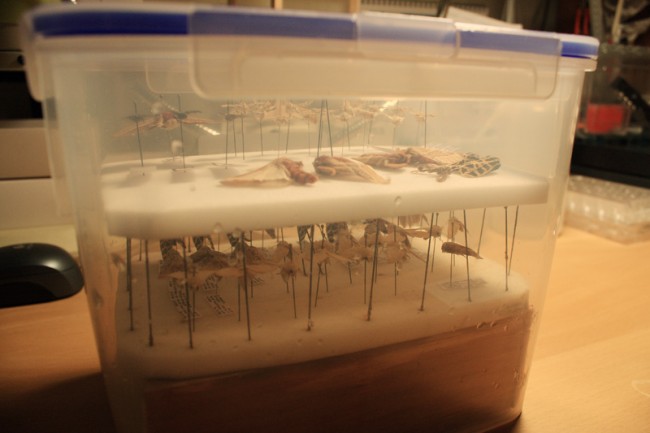 من یک قاب پشتیبان را با بریدن قسمت پایین و سپس بیرون آوردن یک ظرف کوچکتر Tupperware ایجاد می کنم – اساسا یک تکیه گاه پلاستیکی مستطیلی شکل (قاب در تصویر چوبی است, که روش قدیمی من بود). این باعث می شود سطح سنجاق پایین از آب خارج شود, which means it’s very easy to lift out. Placing the foam directly onto water causes a slight adhesion that makes removal difficult, especially without dripping or splashing. Within the frame I stuff paper towels for absorbance.
من یک قاب پشتیبان را با بریدن قسمت پایین و سپس بیرون آوردن یک ظرف کوچکتر Tupperware ایجاد می کنم – اساسا یک تکیه گاه پلاستیکی مستطیلی شکل (قاب در تصویر چوبی است, که روش قدیمی من بود). این باعث می شود سطح سنجاق پایین از آب خارج شود, which means it’s very easy to lift out. Placing the foam directly onto water causes a slight adhesion that makes removal difficult, especially without dripping or splashing. Within the frame I stuff paper towels for absorbance.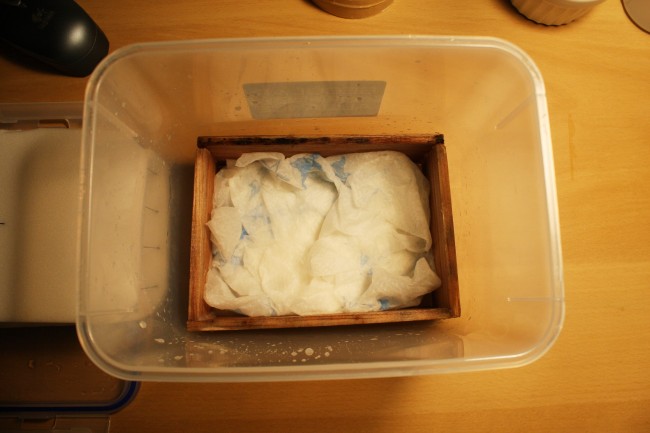 Add enough tap water to moisten the towels but be careful not to allow for standing water. This is just a precaution to avoid splashing, especially if the container is bumped or knocked over. Recently I’ve been using deionized water, which seems to work faster than tap water; and I avoid using hot water because the excess steam creates too much condensation that can drip onto the specimens. My theory is the slower the better, no reason to rush good specimens! اما اگر عجله دارم، آب گرم اضافه میکنم یا آرامکننده را به آرامی گرم میکنم و مطمئن شوید که لایه بالایی را به عنوان محافظ چکه خالی میگذارم.. هنگام استفاده از آب گرم، حتما بالای ظرف خود را عایق بندی کنید تا در برابر تراکم مقاومت کند. اما, گرما می تواند باعث ایجاد چربی اضافی در برخی گونه ها شود, بنابراین باید از این امر اجتناب شود مگر اینکه کاملاً ضروری باشد!
Add enough tap water to moisten the towels but be careful not to allow for standing water. This is just a precaution to avoid splashing, especially if the container is bumped or knocked over. Recently I’ve been using deionized water, which seems to work faster than tap water; and I avoid using hot water because the excess steam creates too much condensation that can drip onto the specimens. My theory is the slower the better, no reason to rush good specimens! اما اگر عجله دارم، آب گرم اضافه میکنم یا آرامکننده را به آرامی گرم میکنم و مطمئن شوید که لایه بالایی را به عنوان محافظ چکه خالی میگذارم.. هنگام استفاده از آب گرم، حتما بالای ظرف خود را عایق بندی کنید تا در برابر تراکم مقاومت کند. اما, گرما می تواند باعث ایجاد چربی اضافی در برخی گونه ها شود, بنابراین باید از این امر اجتناب شود مگر اینکه کاملاً ضروری باشد!- سینی های فوم سنجاق را برش دادم تا جا بیفتد. استفاده كردن #7 پین ها (ضد زنگ بهترین خواهد بود) من یک محیط ایجاد می کنم که در بالای آن می توان چندین لایه سینی را در یک ظرف قرار داد; دو پین وسط به صورت کششی قرار می گیرند. لایه زیرین نمی تواند نمونه های بزرگ با بال های تا شده از پشت را در خود جای دهد, اما آنها می توانند در لایه بالایی یا زمانی که فقط از یک لایه استفاده می شود قرار بگیرند.
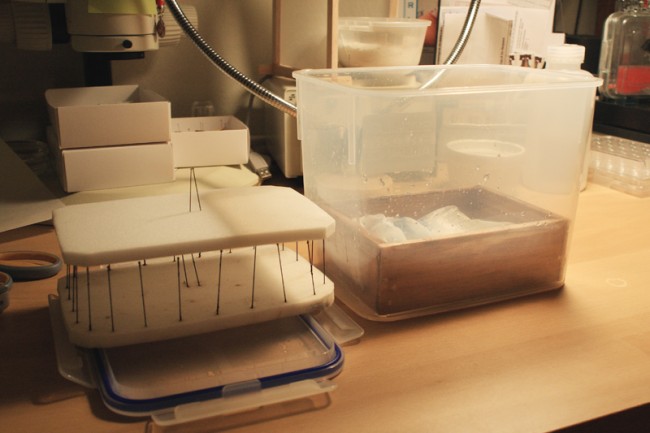
- سپس نمونهها را بارگذاری میکنم و در آرامکننده قرار میدهم. For papered specimens I simply place them flat onto the foam, but it is inefficient space-wise. It usually takes 6-8 hours for microleps to be relaxed, 1 day for small or delicate leps like slender Noctuids or Geometridae and 2-3 days for the majority of Noctuidae and even Saturniidae. Sphingidae seem to usually take 4-5 روزها, and stubborn ones I inject with a small amount of water to facilitate relaxing. I can typically spread the contents of one relaxer in 4-5 ساعت ها (sometimes spread over 2 nights) and since I only have 20 spreading boards I never have had the need for constructing a second relaxing chamber.
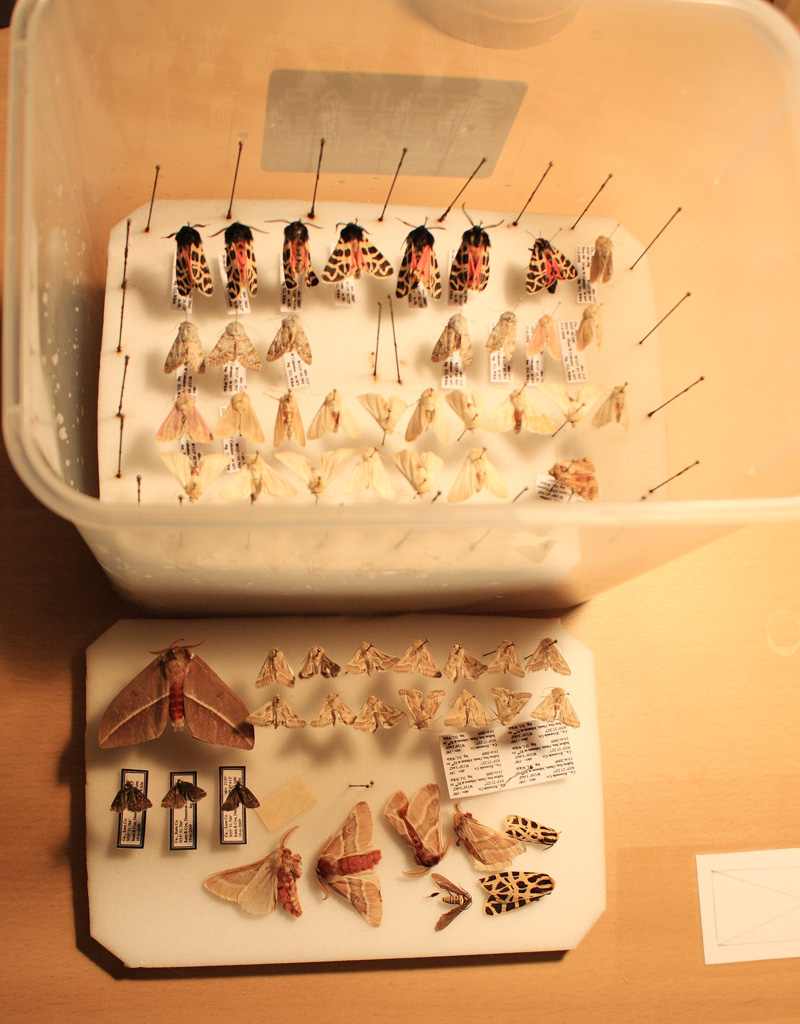
- I do NOT add any chemical mold repellant such as chlorocresol, naphthalene or PDB. I used PDB for a few years but the vapors are extreme, especially when working at your desk for hours. Instead I carefully wash all surfaces with 95% Ethanol for sterilization after each use (boiling water might be substituted). I allow for only a minute ethanol residue because excess alcohol inhibits proper relaxing and you end up with crispy wing-joints, even after a week. While this method prevents mold for 5-6 days it is not fool-proof. I have forgotten about specimens and within 7-8 days some light mold will begin. Despite this, I find this method creates the most satisfactorily relaxed specimens out of anything I’ve tried.
نتایج!
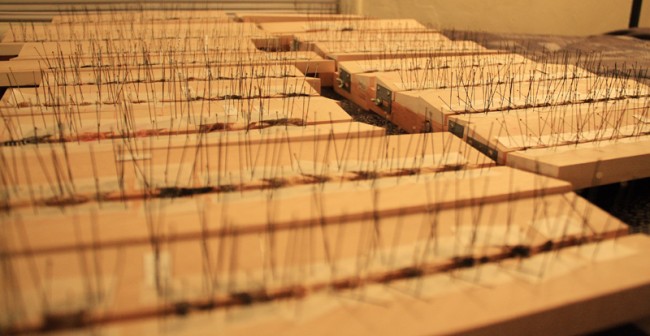

dude.
Im definitely going to have to try this, the only method I ever learned for leps was dipping the thorax in boiling water. I never liked the idea and always had mixed results. Have you tried relaxing other insect groups this way?
جهت مشاهده فرم خرید, من از راه اندازی و مفهوم وب سایت شما و لذت بردن از یادگیری در مورد کارهایی که Lep freaks انجام می دهند را دوست دارم 🙂
بله این برای هر گروهی از حشرات خوب عمل می کند, من هیمنوپترا را به این روش با نتایج عالی آرام کردم. اگرچه برخی از آن سوسک های واقعا بزرگ تلاش بیشتری می کنند, و من هیچ کمکی در آنجا ندارم!
من می توانم تصور کنم که روش غوطه وری خشن است, سعی می کنم از تماس با آب جلوگیری کنم.
در اینجا یک روش آرامش بخش جایگزین است که می توانید برای آرامش سریع از آن استفاده کنید: کار را به سرعت انجام می دهد، اما چیزها را نیز بسیار مرطوب می کند.
http://www.insectnet.com/videos/instruct/billrelax/billrelax.htm
تشکر!
سلام,
آیا میکرو lepidoptera را آرام کرده اید؟ ???
منظورم همان کوچک است.
و چگونه می توانید کنترل کنید که پروانه خیس نشود ??
توجه
لیف
برای پروانه های بسیار کوچک آرام نمی شوم – چیزهایی مانند Nepticulidae باید در حالی که تا حدی زنده یا بسیار زنده هستند پخش شوند, خیلی تازه کشته شده. Most tiny species need to be mounted this way if at all. When I find them in a light trap I just pin them without spreading. But when they are on a sheet I capture in small vials for prep under a microscope the next day.
Keeping the water at room temperature keeps the condensation minimal. I never have had drops forming on specimens.
what do i do if i relaxed a bug like 3 times like 3 days each and it is still not flexible. it is a stag beetle and the legs move, not the mandibles
Beetles are a special case and often require a totally different method for relaxing. Quickly submerging a specimen in warm or simmering water can do the trick – gentile relaxing at room temperature is really only for delicate specimens like Lepidoptera. You might want to search around on beetle blogger sites for better advice on relaxing big, stiff, beetles. موفق باشید!
“فقط” 20 spreading boards?! I am so envious of you and your mothing skills. I constructed my spreading board myself due to budgeting and it’s a bit… wanting.
در هر صورت, my question is this. I capture most of my specimens around 9 or 10pm, and directly move them into my kill jar. I leave the jar overnight and spread them in the morning around 8am. I’ve noted some difficulty in spreading the antennae and wings; the antennae tend to curl and the wings are always pressed tightly against the body, making it difficult to extract them without damage and sort of spring-loaded, wanting to return to the body as soon as I let go of the forceps. I am not an experienced spreader/pinner, همانطور که اخیراً انتشار نمونه ها را متوقف کردم, و می خواستم بدانم آیا راهنمایی برای من دارید؟. آیا آنها را برای مدت طولانی در ظرف کشتار رها می کنم؟? به اندازه کافی بلند نیست? آیا لازم است فقط یک شب پس از دستگیری آنها را آرام کنم؟?
خیلی ممنون, وبلاگ شما برای یک حشره شناس مشتاق که دوستانش واقعاً این کار را نمی کنند، شگفت انگیز و الهام بخش است “آن را دریافت کنید”… من سال آخر دبیرستان هستم و منابع لازم برای lepidoptergeekery را ندارم! لطفا به نوشتن ادامه دهید.
اولیویا
ممنون از نظرت اولیویا! از چه نوع کوزه کشتار استفاده می کنید؟? ممکن است آنها را برای مدت طولانی ترک کنید, اگر آنها را در طول شب رها کنم، قبل از پخش کردن، آنها را برای چند ساعت آرام می کنم تا به شل شدن همه چیز کمک کنم. اگر در خانه جمع آوری می کنید، باید از فریزر خود نیز استفاده کنید. اگر چیزها را در یک ظرف کشتار خراب کردید، می توانید آنها را با مقداری دستمال کاغذی به یک ظرف بزرگ منتقل کنید و در فریزر قرار دهید.. وقتی آن را جدا میکنید، قبل از اینکه دوباره شروع به پخش کردن کنید، حداقل یک ساعت یا بیشتر اجازه دهید به دمای اتاق برسد, همه چیز باید کاملا تازه باشد.
من فقط یک کوزه کشتن موقت را با یک شیشه کنسرو و یک توپ پنبه ای آغشته به لاک ناخن را با هم درست کردم. از این به بعد از فریزر استفاده خواهم کرد, گرچه, خیلی ممنون!
من یک دستمال حوله را در ظرف پتری با سرکه خانگی مرطوب می کنم تا گل بال را آرام کند. در صورت نیاز آنها را به مدت 24 ساعت یا بیشتر بگذارید. این برای من خوب کار می کند. اگر آنها را برای مدت طولانی تری رها کنید، با کپک هم مشکلی ندارید.
سلام, i am debasish working on red banded mango caterpillar and i want to make the adult spread for preservation, can somebody help me to achieve that goal.
Am new to microlepidoptera………..but having a blast exploring the fauna of my area. The problem!……..pinning. I have collected coleoptera for over 40 years and that’s a pice of cake compared to micro-leps.
The specimens whose wings are basically flat when captured sem to be no problem regardless of size, but the moths which have sort of a triangular, pyramidal shape are the tough ones for me…….I succeed with about 1 به 10 !!! can’t seem to get the wings moved forward regardless of how carefully I use the pins without tearing or them breaking completely off.
The other problem are the ones where I move the forewing forward and then it flips up creating a long tear in the wing.
Help!!!!
Mike Poellot Saratoga, کالیفرنیا
Oops sorry for the late reply! Yes when a moth dies with the wings vertical it’s very hard to prepare the specimen. I pin the moth between my fingers as if it’s a large butterfly – then I use two forceps to manipulate the specimen upside down. One pair holding it over the foam and the other pair opening the wings as I pin it down. From there you can then gently pull the wings forward for spreading (if that makes sense?) It takes lots of practice with those!
سلام وجود دارد
does anybody like to share some tipps about how you’re relaxing large saturniidae like for example an Argema mittrei or Actias luna?
How to prevent the hairy body to catch too much humidity and still to get the muscles very tender relaxed. And the wings not getting soaked in humidity?
Maybe placing the specimen vertically in the relaxing box or conventional laying on a cotton surface?
Would appreciate a lot if somebody could describe here how you’re handling the process. I had an incident with an Actias luna which turned to be destroyed – water was sticking together the hairs on the body….
Any help and tipps are very appreciated.
Sounds like you’re leaving them in too long or using hot water? With room temp water even a big moth won’t become perfectly relaxed, but you can try injecting some warm water directly into the body to speed things along. سرنگ های کوچک ارزان هستند و به راحتی آنلاین خریداری می شوند. می توانید کمی آب گرم به پروانه تزریق کنید و سپس آن را آرام کنید 24 ساعت ها, که باید کافی باشد.
باشه – بزرگ, بسیار سپاس گزارم. از آن تکنیک برای پاپیلو آنتی ماچوس استفاده کرد. کاملا خوب کار کرد. در واقع من به طور معمول از آب گرم در جعبه آرامش خود استفاده می کنم.
همانطور که شما می گویید من باید با آب دمای اتاق امتحان کنم.
سلام,
من چند سالی است که پروانه ها و پروانه ها را سوار می کنم اما هنوز هم سعی می کنم آرامش کامل داشته باشم. اگر از آب استفاده کنم, نمونه ها قالب می گیرند 3 روزها و قبل از اینکه برخی آرام شوند. من پست های یک گروه کامل از بچه ها را خواندم که از ودکا به عنوان مایع آرامش بخش استفاده می کردند. من در ماه گذشته از آن استفاده می کنم با نتایج متفاوت. من دیگر کپک نمی گیرم اما بسیاری از کیوان ها بدن اشباع شده ای دارند که موها را تشکیل می دهد.. Maybe the problem has to do with the apparent need to inject fluid (vodka) into the bodies. در غیر این صورت, heavy bodied specimens won’t relax sufficiently, even after 4 روزها. I bought a can of P-Choro-m-Cresol from Bioquip to add water but I don’t have any idea how much of the crystals to add to how much water. هر گونه ایده ها? It doesn’t seem that any of you are using this method, but I am open to any and all suggestions.
Randy
I think one of the necessary things to do when using only water is to sterilize your container as much as possible – that can help with mold issues. But for large bodied moths and beetles you can inject a little warm water into their thorax before relaxing (you could cut it with alcohol, but I never found it necessary as long as you make sure you dry the specimens after). این به کاهش زمان مورد نیاز کمک زیادی می کند و واقعاً به نفوذ در عضلات متراکم کمک می کند. کلروکرزول می تواند کار کند اما چیز بدی است, بوی تند بر جای می گذارد و به طور بالقوه دارای عوارض جانبی خطرناک انسانی است. باقیمانده روی نمونهها همچنین میتواند باعث شود که در آینده حتی با کمی رطوبت به راحتی آرام شوند., باعث افتادگی نمونه ها می شود.
کریس,
با تشکر برای مشاوره.
در استریل کردن ظروف آرامش بخش, آیا شستشو در ماشین ظرفشویی کافی است یا چیزی دقیق تر توصیه می کنید? من از ظروف نگهداری مواد غذایی rubbermaid استفاده می کنم.
همچنین, من قصد دارم از Lysol استفاده کنم. هر ایده ای در مورد آن?
Randy
ماشین ظرفشویی عالی خواهد بود – اما من در مورد آن سختگیر نیستم. من فقط با 95% اتانول یا من از آب جوش استفاده می کنم. این معمولاً به اندازه کافی از چیزها مراقبت می کند.
کریس,
I’m finally getting around to standardizing the mounting height of the butterflies in my collection. It will be a fair task now that I have accumulated about 300 of them. I have a pinning block that I bought from Bioquip but I see a problem with it’s use. It standardizes the position of the bottom of the specimens rather than the tops. Since I have everything from tiny blues to the largest Saturnids, this poses a problem. It seems that I should be wanting to standardize the position of the top of the wings, or at least the tops of the thoraxes rather than the bottom of the thoraxes. What spacing should I use between the bead on the tops of the pins to the tops of the thoraxes?
Randy
I standardize the height by pinching the top of the pin and moving the specimen up to that height. It’s enough that my fingers don’t touch the specimen, and I just eyeball it – turns out to be about ~.4″/10میلی متر. Half an inch is a bit much, and you don’t want the specimen being too close to the top such that fingers would contact the specimen. Some pinning blocks (the Rose Entomology design aluminum ones) have a larger hole that fits a pin head, which is exactly 10mm for distancing specimens down from the top.
I’ve a number of problems setting moths.
Particularly noctuids e.g. darts (and I have the same problems with skippers too).
These insects are strong fliers, that hold their wings in a low v shaped tent folded into the body.
Even if these are fresh, moving the forewing into position often causes the joint at the body to fold in on itself (the forewing twists at the joint). I’ve tried relaxing the specimens but to no avail.
It’s difficult to present them to the board at the right height because the wings slip into resting position into the grove – which means lost scales when I try to flatten them onto the setting surface.
What am I doing incorrectly?
It’s getting frustrating.
I read once in a Peterson guide that you could cut the joint below the wing with a fine blade, but this doesn’t seem worth it, and perhaps isn’t necessary – but with these particular moths especially (given the wing position) one can’t even attempt this because you can’t see the wing base.
Am I not relaxing these fresh specimens for long enough?
I feel like I’m missing something obvious.
On another subject, where can I get really good fine point forceps?
Thanks in advance for any suggestions.
بهترین,
Matt.